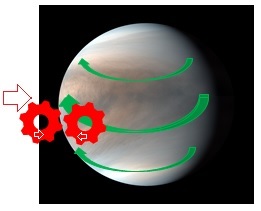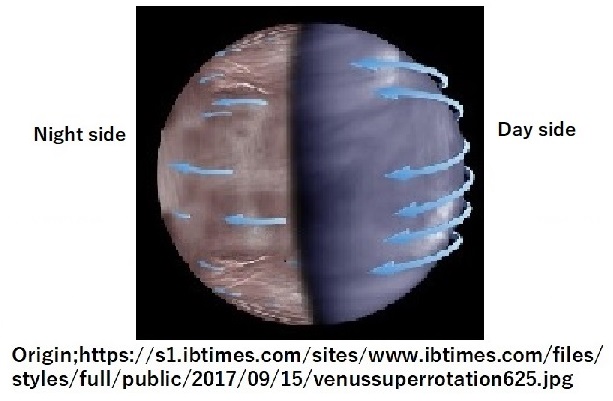4.5 Mechanism of superrotation on Venus
Venus has slightly less mass than Earth, but its atmospheric pressure
is 90 times higher than Earth. On the other hand, the speed of the solar
wind is about 2 km/s and it collides with Venus at 350~900 km/sec. When
the solar wind, which has a counterclockwise rotating component due to
the rotation of the Sun, hits the equator in the day hemisphere of Venus,
the solar wind rotates Venus' atmosphere in the direction of clockwise
rotation like gears meshing, causing a "super rotation" to orbit
Venus at 100 meters per second.
Fig.9 shows a model of the effect of solar wind on Venus' atmosphere. Fig.(a) shows the morning air flow in the day hemisphere of Venus, and Fig.(b) shows the morning air flow in the day side together with night side of Venus. On the western side, the passing solar wind accelerates, so the air flow becomes wider.
The airflow is shaped by tilting the letter Y 90 degrees counterclockwise. On the other hand, on the eastern side of Venus, the passing solar wind is in the opposite direction of the superrotation.
Wrinkles of air currents form on the dawn side. The right side of Fig.2(b) is the air flow caused by the solar wind passing through the east side, and the left side is the clockwise atmospheric flow driven by the day hemisphere.


Fig.9(a) Effect of solar wind on day side of Venus Fig.9 (b) Effect of solar wind on night side and day side
4.6 Verification of the quantitative effect of solar wind on Venus
Rotation of a planet is usually in the same direction as the planet's revolution when it grows.
However, Venus is now rotating very slowly in a clockwise direction. Therefore, there is a theory that Venus collided with another planet and the rotation axis was reversed,
but it is impossible for Venus, which orbits in an orbit that is close to the perfect circle among the planets in the solar system, to reverse its rotation axis due to collision.
Since Venus has a thick atmosphere and is close to the Sun, we will verify
the theory that the strong trade winds driven by the solar wind in the
clockwise direction are superrotation. The amount of H+ emitted by the Sun today is MP+ from Sun=109 kg/s, and the amount of H+ of the solar wind impacting Venus is approximate.
Distance from the Sun to the orbit of Venus (1.08x108
area of the spherical surface with a radius of SSun-Venus sphere=1.46x1016km2 and
The cross-sectional area of Venus SVenus = π (6,052 km) 2 = 3.14(3.662x107km2) ratio (γ) is γ
= (1.15x108/14.6x1016) = 0.79x10-9,
The mass of H+ impacting Venus is 0.79 kg/sec. Suppose that the solar wind has an east-west velocity of 1.89 km/sec due to the rotational motion of the Sun. The kinetic energy derived from rotation (Krotation) is
Krotarion=(1/2)Mv2=0.394x3.57x106=1.406x10 6 J/sec
.
On the other hand, assuming that the translational speed of the solar wind
is fast< > SUP and the speed of >kinetic energy of solar wind
Kkinetic energy of solar wind= (1/2)Mv2=0.394x36x1010=1.42x1011J/sec.
If the kinetic energy of the solar wind flying to Earth every second is
accumulated for 4 billion years, it will be multiplied by 40x109x365x24x3600=1.26x1017. Therefore, the energy of motion derived from the rotation of the Sun accumulated for 4 billion years is 1.77x1023J, and the energy derived from translational motion is 1.79x1028J.
On the other hand, the moment of inertia I of a uniform sphere is I = (2/5)Mr2 and the mass of Venus M = 4.87×1024kg, Venus' radius r = 6.052x106m, and the moment of inertia is I=(2/5)Mr2 =7.13x1037 The angular rotation velocity of the current Venus rotation of Venus is 243 days and 1 revolution ω = 2π / (243x24x3600) = 3.0x10-7 rad/sec
The kinetic energy of its rotation is K=0.5x7.133x1037(x(3x10-7)2≈3,2×1024J.
Assuming that the early Venus had one revolution per day, the angular
rotation velocity of ω=2π/(24x3600)=7.26x10-5 rad/sec
The rotational kinetic energy of its rotation is K = (1/2) Vω2 = 0.5x7.133x1037(x(7.26x10-5)2≈1.88×10 It will be 29J. This is 10 times the value of the kinetic energy due to the translational
motion of the solar wind. Furthermore
to index -4.3-